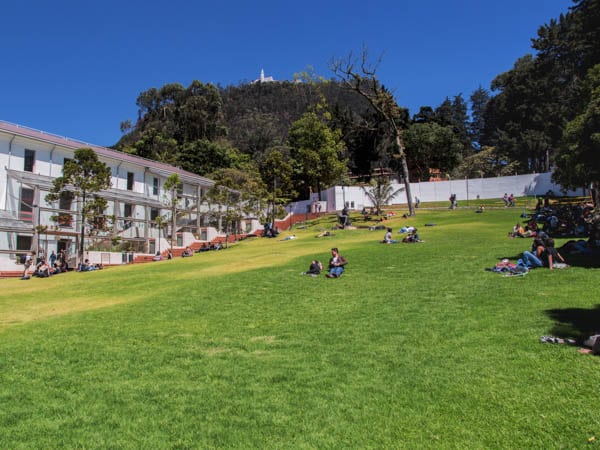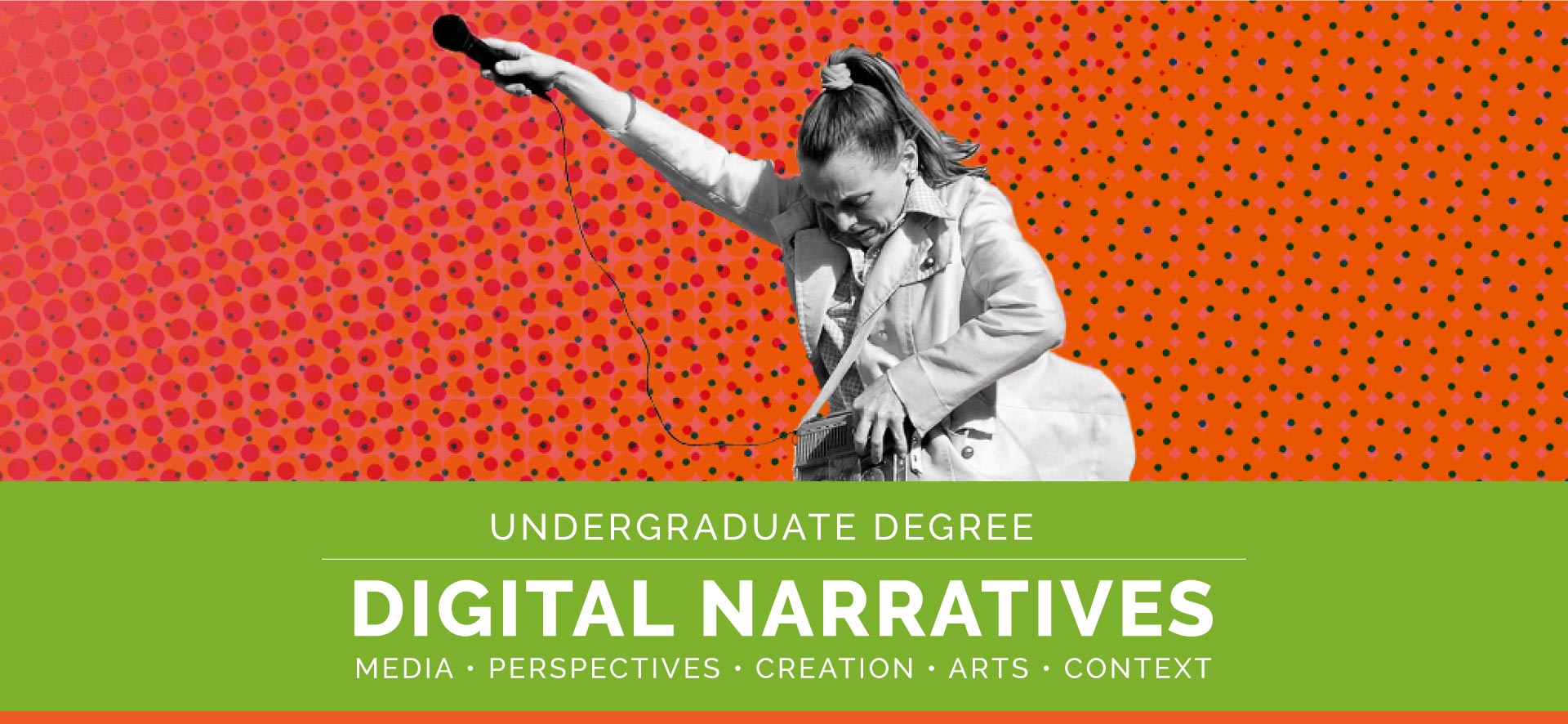The Universidad de los Andes undergraduate program in Digital Narratives is innovative in Latin America. It explores the intersections between formats, technologies, media, and the arts to imagine an expanded narrative in digital universes.
The fundamental objective is for the student to investigate, reflect, and intervene creatively and critically in the digital environment. It emphasizes learning the methods of journalism (tools, modes of research, and storytelling), media narrative (television, video, radio, press, film), the aesthetic and expressive possibilities of some communication languages (audio, visual, digital, body) and the criteria, tools, and practices of digital creation (such as networks and devices).
The program is highly flexible. Half of the subjects of the curriculum are from General Education, electives, language, and other programs of the School of Arts and Humanities.
Of the undergraduate courses, 30 credits correspond to workshops (writing, sound, audiovisual, corporal, and transmedia), 28 credits to thematic theoretical courses (context, communication, and technology), and four credits to the degree project, which may have an emphasis on research, creation or practice.
Transversal workshops [30 credits]
In the workshops, through practical work, the student learns to create and produce narratives in different languages and formats: written, audio, audiovisual, corporal, and multimedia. There are three workshops for each of the five languages: an initial exploration workshop and two others to develop fiction and non-fiction narrative projects.
Written language [6 credits]
In this series of workshops, the student understands and practices the uses, particularities, and possibilities of written language for public communication.
Audio language [6 credits]
The digital environment has expanded the field of audio communication. In these workshops, we work on the classic narratives of audio languages —such as radio and music— and other formats, such as soundscape, radio documentary, or podcast.
Audiovisual language [6 credits]
In these workshops, the student understands and practices the different ways of thinking and narrating with images and sound. The modes of storytelling in cinema, documentary, video, series, and video games, among other audiovisual formats, are explored.
Body language [6 credits]
The body is the place of communicative enunciation par excellence. These workshops seek that the student assumes his own body as a device to narrate and establish relationships with digital expressive environments, exploring formats such as performance or monologue, with or without the mediation of other formats (live or video, for example).
Multimedia and transmedia language [6 credits]
In these workshops, the student understands and practices how different formats and narrative languages coexist and intertwine in digital environments.
Thematic courses [28 credits]
The thematic theoretical courses are grouped into three areas: context, communication, and technology. These subjects seek to develop critical and reflective views of interdisciplinarity, emphasizing the articulation of digital narratives with socio-cultural contexts, the cultural industry, media history, political and power relations, entertainment culture, and technologies.
The courses in the context area [10 credits] address the production of media narrative in terms of its evolution over time; this enables us to consider the relationship between these processes and their environments and propose comparative reflection angles between the past and the present.
We also offer courses on the functioning and contents of the media concerning the powers and their symbolic and material expressions in contemporary society.
The courses in the communication area [10 credits] deal with the products of entertainment cultures (such as television series, soap operas, movies, and documentaries, among others) and popular cultures (carnivals, popular festivals, folklore, among others). The approach to these topics focuses on audiences’ consumption and appropriation and the critical analysis of media and diverse narratives as autonomous expressions that also make up the panorama of communication.
The subjects in the technology area [8 credits] study languages and ways of telling and producing stories in formats typical of contemporary societies permeated by the use of communication technology (such as animation, video games, and data visualization, among many others).
Undergraduate Degree Project [4 credits]
The degree project has two courses: Degree project 1 and Degree project 2. There are three modalities of degree project:
[Research] Theoretical investigative degree project making a critical reflection on an aspect of digital narratives.
[Creation] Narrative degree project in which a digital product is designed and produced in a specific language (written, audio, audiovisual, corporal, or transmedial).
[Management] Practical degree project that requires the student to work in an institution, media, or content production company. A final report of the experience must be submitted.
Courses in other fields of study and languages
The undergraduate program in Digital Narratives focuses on human and social sciences. It encourages a type of research and creation of flow, processes, interaction, and connections. Therefore, it emphasizes teaching through projects based on experiences of knowledge, research, and collaborative creation in art, art history, music, literature, and design, among others.
Of the 123 credits of the program, the student takes 21 credits in General Education courses, 18 credits in elective courses, 16 credits in subjects from other programs of the School of Arts and Humanities, and 6 credits in Languages.



Goals
The digital storytellers will be able to:
- Tell digital stories (narrate), connect with their audiences (communicate), and responsibly influence the social environment.
- Understand the characteristics and uses of audio, audiovisual, written, corporal, and transmedial languages to narrate and communicate.
- Construct innovative narratives that critically dialogue with the current political, social and cultural environment.
- Understand interdisciplinary theoretical and historical references that articulate languages, culture, media, and technology.
- Recognize the existence and meanings of cultures (ancestral, minority, marginal, for example) to research and create other public models of social narration.
Applicant’s Profile
The program in Digital Narratives is aimed at the generation of digital natives who grew up when computers and the Internet had permeated almost all aspects of daily life: digital citizens who are engaged in the world of media and images, hyper-connected and linked in dynamic networks.
The program offers tools and opportunities for reflection and practice so the student can be an architect, critic, and creator of the new digital media universe.
Graduate’s Profile
The program graduates are professionals who know the languages, formats, tools, and referents of digital creation. They know how to use this knowledge to research, narrate, communicate and work in a collaborative and interdisciplinary manner. They have an experimental, ethical and critical attitude towards their work and the work of others.
Their work field is as broad and interdisciplinary as their profile. They will be able to join the media, digital and content agencies, public, mixed, and third sector entities and develop their ventures. In these contexts, they can lead and be part of work teams to create and manage journalistic, advertising, fiction, and divulgation content, among others.


